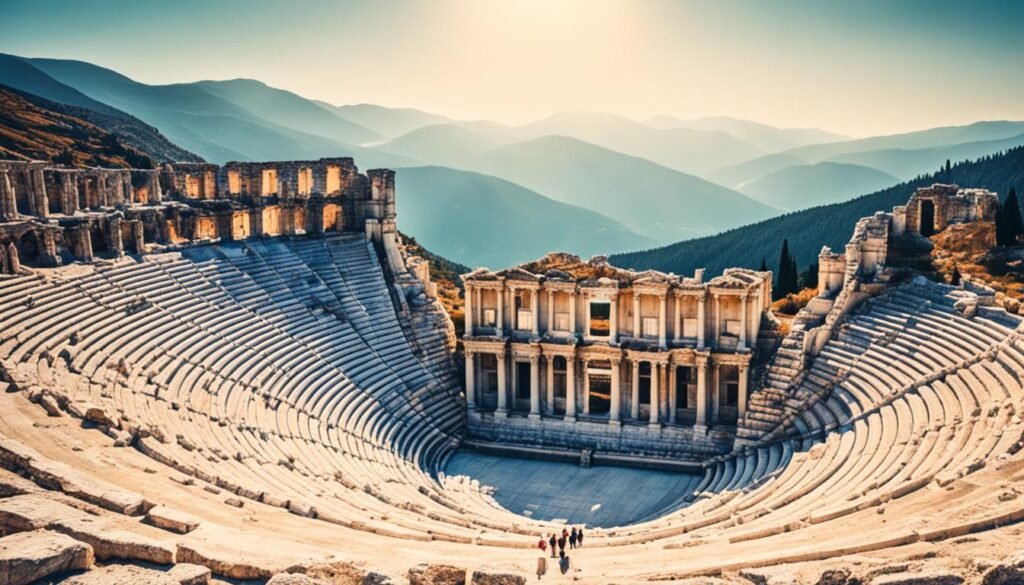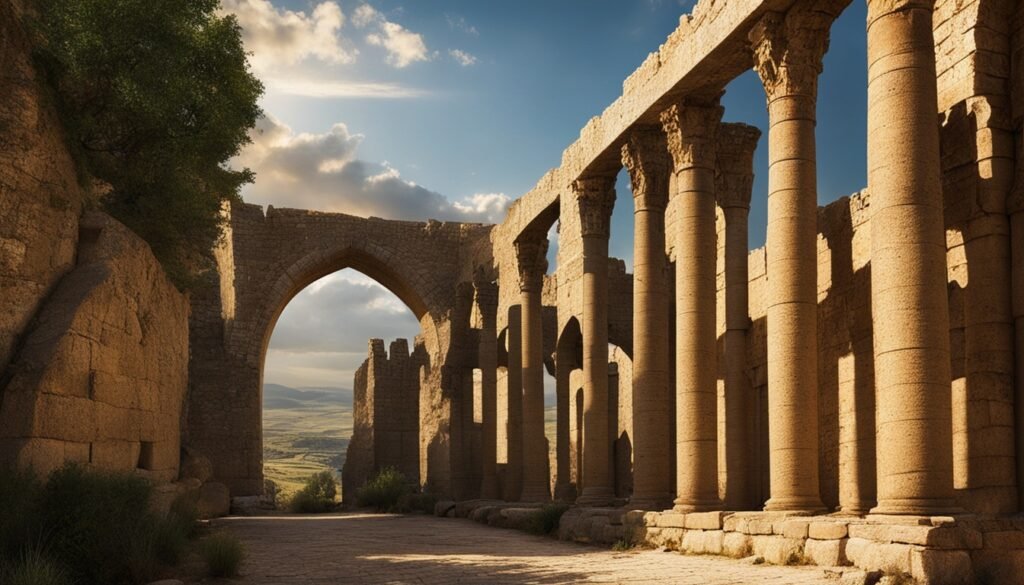Turkey is a top spot for cultural tourism, with a mix of history and diversity. It connects Europe and Asia and has 21 UNESCO World Heritage Sites. These sites tell stories of ancient empires, sacred places, and big achievements. They show Turkey’s rich history and tradition.
Göreme National Park and the Rock Sites of Cappadocia are big draws with stunning landscapes. Pamukkale, known as the “Cotton Castle,” has beautiful terraces and ruins. Istanbul is famous for sites like Hagia Sophia, Topkapi Palace, and the Blue Mosque, showing its cultural growth.
Turkey also has sites like Troy, Mount Nemrut, and Ephesus, showing its long history. Places like Safranbolu, Çatalhöyük, and Göbeklitepe offer something for every culture lover. They are among the oldest and most mysterious places in the world.
Key Takeaways
- Turkey boasts 21 UNESCO World Heritage Sites, emphasizing the country’s rich cultural heritage.
- Göreme National Park and Cappadocia’s rock sites are among the most visited in Turkey.
- Pamukkale’s travertine terraces and Hierapolis have attracted visitors for centuries.
- Istanbul’s historic sites, like Hagia Sophia and Topkapi Palace, attract global tourists.
- Turkey preserves its cultural legacy through various well-preserved ancient cities and structures.
- Ephesus offers insights into Roman architecture, making it a top destination for history enthusiasts.
- Sights like Troy and Mount Nemrut combine history with natural beauty, drawing diverse visitors.
Discover Ephesus: A Journey Through Time
Ephesus is a key piece of ancient architecture and city growth. It’s a UNESCO World Heritage Site where visitors can see the remains of a lively ancient city. Every year, millions of tourists visit, making it a top historical site in Turkey.
The Library of Celsus
The Library of Celsus shows the city’s love for books. It once held nearly 12,000 scrolls and was built to honor Roman Senator Tiberius Julius Celsus Polemaeanus. Its design, with Corinthian columns, shows the beauty of Roman architecture.
The Temple of Artemis
The Temple of Artemis was one of the Seven Wonders of the Ancient World. Though only one column stands today, it was once huge, made of marble with detailed sculptures. It shows Ephesus’s big role in ancient times.
The Great Theatre
The Great Theatre Ephesus could hold up to 25,000 people, showing its cultural and social importance. This big theater still brings back the artistic and political talks of old Ephesus. Its ruins connect us to its rich history.
There are many ways to see Ephesus, for groups big or small, and for any budget. A standard tour lasts about 5.5 hours.
| Group Size | Price per Person (USD) |
|---|---|
| 1 PAX | $396 |
| 2 PAX | $216 |
| 3 PAX | $153 |
| 4 PAX | $126 |
| 5 PAX | $98 |
| 6 PAX | $90 |
| 7 PAX | $83 |
| 8 PAX | $75 |
| 9 PAX | $68 |
| 10 PAX | $60 |
Many people visit Ephesus and also go to Selçuk, seeing more history and culture. The Library of Celsus, the Temple of Artemis, and the Great Theatre Ephesus all tell stories of the past.
While in Turkey, don’t miss other great places. Sydney is another city full of culture, with famous spots like the Sydney Opera House and historic areas like The Rocks. It’s a mix of old and new attractions.
The Ancient Wonders of Göbeklitepe
Göbeklitepe is a fascinating site, 15 kilometers from Anlıurfa in Turkey. It shows us the amazing skills of ancient humans. This place is over 12,000 years old, making it the oldest temple in the world. It’s even older than Stonehenge by 6,000 years.

The World’s Oldest Temple
Göbeklitepe is the oldest known temple in the world. It changes how we see early human societies. The site has T-shaped obelisks with detailed carvings of wild animals. These obelisks are 3 to 6 meters long and weigh 40 to 60 tons.
This shows us the skill and beliefs of early humans. The size and detail of these structures are amazing.
Archaeological Discoveries
Göbeklitepe has made big discoveries in Turkey. It has over 200 pillars in about 20 circles. Each pillar can be up to 6 meters tall and weigh up to 10 tons.
In 2018, Göbeklitepe was added to the UNESCO World Heritage List. This made it a key place for history lovers and scholars.
Göbeklitepe is more than just old and big. It was where hunter-gatherers came together before farming started. This makes it a special place in human history.
Visiting Göbeklitepe helps us understand ancient architecture better. It also connects us to the lasting legacy of human culture.
| Category | Detail |
|---|---|
| Location | 15 kilometers (9.32 miles) from Anlıurfa, Turkey |
| Age | Over 12,000 years old |
| Structure | More than 200 pillars in about 20 circles |
| Included in UNESCO | 2018 |
| Notable Features | T-shaped obelisks with intricate carvings |
Sardis: Revisiting the Lydian Empire
In Turkey, the city of Sardis is a must-see for history lovers. It was a key city in the Lydian Empire, known for its wealth and culture. Walking through its ruins feels like stepping back in time, where stories of wealth, conquest, and heritage come alive.
Home to King Croesus
King Croesus ruled Sardis at its peak. His name is linked with incredible wealth. Today, Sardis shows off the luxury of his time through palaces, temples, and other grand buildings.
It’s a place where legends and history meet. Sardis is a treasure trove of Lydian culture and prosperity.
Alexander the Great’s Influence
Alexander the Great left a mark on Sardis too. He added Greek culture and architecture to the city. Today, you can still see these influences in the ruins.
Artifacts and buildings from Alexander’s time fascinate historians and travelers. They connect Sardis to the ancient world’s vast history.
For those wanting to learn more about Sardis, this resource talks about preserving its history. The work of King Croesus and Alexander the Great makes Sardis a key spot on Turkey’s cultural trail. It’s where ancient grandeur and modern appreciation meet.
| Key Figures | Historical Significance |
|---|---|
| King Croesus | Synonymous with immense wealth and prosperity within the Lydian Empire |
| Alexander, the Great | Introduced Greek culture and architectural styles post-conquest |
Exploring the Ruins of Sagalassos
Sagalassos is 60 miles from Turkey’s southwestern coast, offering a peek into Turkey’s architectural past. Walking through its ancient ruins, I felt the city’s grandeur from ancient to Byzantine times. It had a 9,000-seat theater, one of the highest in the world, showing its smart city planning and engineering.
Excavations have found a well-preserved city center, big fountains, and detailed mosaics. The huge statues of Hadrian and Marcus Aurelius are a sight to behold. Local workers, skilled in traditional building, help keep this heritage alive.

Sagalassos also shows how ancient sites can help rural areas today. Nearby, women learn to make ceramics, boosting their income and culture. Since 2002, the Global Heritage Fund has worked with over 100 groups in 19 countries to protect places like Sagalassos.
Visiting Sagalassos is both enriching and budget-friendly. In 2020, tickets were just 14 TL (about 2.05 USD), or 60 TL for a year of museum access in Turkey. Its long history, from the 3rd century BC to the 13th century AD, makes every step interesting.
For those who love adventure, Sagalassos is perfect for hiking, mountaineering, and eco-tourism. The tough terrain once kept looters away but now draws adventurers. Walking here feels like a trip through time, showing off Turkey’s famous ancient ruins.
| Fact | Detail |
|---|---|
| Location | 60 miles from the coast in southwestern Turkey |
| Theater Capacity | 9,000 seats |
| Historical Figures | Statues of Hadrian and Marcus Aurelius |
| Local Crafts | Masonry and ceramic-making in Ağlasun |
| Entry Fee (2020) | 14 TL (~2.05 USD); Müzekart: 60 TL |
| Visiting Hours | Vary by season: 08:30-17:30 (Oct 31 – Apr 1), 09:00-19:00 (Apr 1 – Oct 31) |
The Historic Significance of Hattusha Boğazköy
Hattusha Boğazköy was the vibrant capital of the Hittite Empire. It was built around 1650 BC. Today, it shows us the amazing architecture and arts of ancient Anatolia.

The Capital of the Hittite Empire
In its prime, Hattusha was a powerful city. It controlled areas from Anatolia to northern Syria in the 2nd millennium B.C. The city was protected by an 8-kilometer-long wall.
The Upper City had a double wall with over a hundred towers and five gateways. The Lion’s Gate, King’s Gate, and Sphinx Gate were among them. Yazılıkaya, a rock sanctuary, and Kayalı Boğaz, a strong outpost, add to the city’s mystery.
The Architecture and Arts of the Time
Today, Hattusha Boğazköy shows us the Hittites’ skill in architecture and art. It has the longest Hittite hieroglyphic inscription at Nişantepe. The Great Temple from the 13th century B.C. is a symbol of religious importance.
Yazılıkaya sanctuary, just 2 km away, has detailed stonework of gods, goddesses, and the Great King Tuthaliya IV. These works highlight the advanced architecture and arts of the Hittite Empire in Turkey.
The German Archaeology Institute and Turkish authorities work together to protect Hattusha. Turkey is proud of its 18 UNESCO World Heritage Sites. Hattusha, listed in 1986, is a key part of Turkey’s ancient culture.
The Mystique of Göreme National Park and Cappadocia
Göreme National Park and Cappadocia are known for their dreamlike landscapes and deep Christian history. Their unique rocks and historical sites make them a top spot for those who love nature and culture.

Fairy Chimneys and Unique Landscapes
The fairy chimneys in Göreme National Park stand tall, up to 40 meters high. They were shaped by nature over thousands of years. People started living in these soft volcanic rocks around 1800–1200 B.C. They built homes and tunnels, blending with nature.
- Fairy chimney heights: Up to 40 meters
- First human settlements: 1800–1200 B.C.
- Early Christian settlement: 4th–7th centuries A.D.
- UNESCO World Heritage site since 1985
Rock-cut Churches and Monasteries
In Göreme, you’ll find amazing rock-cut churches and monasteries. Early Christians built them to escape persecution from Rome between the 4th and 7th centuries. There are about 600 of these churches, filled with stunning Byzantine art.
Some famous ones are St. Basil’s, Karanlık Kilise (Dark Church), and St. Catherine’s.
| Church Name | Unique Feature |
|---|---|
| St. Basil’s | Intricate frescoes |
| Karanlık Kilise (Dark Church) | best-preserved Byzantine art |
| St. Catherine’s | Historical significance |
There are also huge underground cities in Göreme National Park and Cappadocia. Places like Derinkuyu and Kaymakli go deep into the earth. They could house thousands of people. Now, visitors can see these underground wonders and learn about the lives of the past.
Hierapolis-Pamukkale: The Cotton Castle
Let’s explore the magic of Hierapolis–Pamukkale, known as the ‘Cotton Castle.’ It’s a place where nature and history meet. Since 1988, it’s been a UNESCO World Heritage Site. It covers 1,077 hectares, showing its cultural and natural beauty.
Thermal Springs and Travertine Terraces
Pamukkale is famous for its travertine terraces. These contain mineral water from hot springs. There are 17 hot springs here, with temperatures ranging from 35°C to 100°C.
Visitors love the thermal springs in Turkey for their beauty. They see white calcium deposits and petrified waterfalls. The waters create a dreamy landscape with step-like terraces.
The Ancient City of Hierapolis
Next to Pamukkale is Hierapolis, a city from the 2nd century BC. It was a thermal spa. In AD 133, it became part of the Roman province of Asia.
Hierapolis was known for its healing waters. A big earthquake in AD 17 damaged the city a lot. Today, you can see a big theatre, temples, and a necropolis over 2 kilometers long.
The Martyrium of St. Philip is a Christian monument from the 4th to 6th centuries. It’s a key part of the city’s spiritual and wellness history.
Hierapolis shows off the advanced water systems of its time. They brought water from Pamukkale springs, over 70 kilometers away. This shows how smart and important the city was.
Hierapolis-Pamukkale is a symbol of ancient civilization’s love for nature and wellness. It’s a place where you can feel history and nature. Whether you’re walking on the terraces or seeing Hierapolis, it’s a deep journey through time.
The Cultural Heritage Cities Turkey: Istanbul’s Historic Areas
Istanbul is a city that has seen centuries of history. It is filled with landmarks that show the mix of Roman, Byzantine, and Ottoman cultures. These areas are not just beautiful but also carry deep cultural meaning.
Hagia Sophia
The Hagia Sophia is a symbol of Istanbul’s history. Built in the 6th century as a basilica, it became a mosque and then a museum. Now, it’s a mosque again. This building shows how Istanbul keeps its culture and faith alive.
Its stunning dome, beautiful mosaics, and detailed calligraphy show the Byzantine and Ottoman arts. It’s a place where history and art meet.
Topkapi Palace
Topkapi Palace was home and work place of the Ottoman sultans for about 400 years. It lets visitors see the luxury of the imperial family. The palace has big courtyards, fancy rooms, and sacred items, showing Ottoman architecture and preservation in Turkey.
It’s where the Ottoman era’s beauty is still alive today.
The Blue Mosque
The Blue Mosque, or Sultan Ahmed Mosque, is another gem in Istanbul. It’s named for the blue tiles inside. The mosque has six minarets and a big courtyard, showing the Ottoman Empire’s greatness.
It’s a place of worship and a tourist spot, balancing its religious and cultural importance.
These historic places in Istanbul show Turkey’s effort to keep its culture alive. Whether you’re at Hagia Sophia, Topkapi Palace, or the Blue Mosque, you’re touching a part of Istanbul’s history that still shapes its culture today.
Pergamon: An Ancient Acropolis
Walking through Pergamon, I felt the ancient city’s grandeur. It stands tall at 39°07′57″N, 27°11′03″E, 335 meters above sea level. This site, now a UNESCO World Heritage Site since 2014, spans 332.5 hectares. A 476.9-hectare buffer zone that displays Hellenistic, Roman, Byzantine, and Ottoman architectural styles surrounds it. Pergamon’s beauty highlights Turkey’s cultural heritage.
The Attalid dynasty founded Pergamon in the 3rd century BC. It became Roman in 133 BC and was a key city in the Roman Province of Asia. Here, we find two landmarks that show Pergamon’s greatness: the Altar of Zeus and the Library of Pergamon.
The Altar of Zeus
The Altar of Zeus is a masterpiece of ancient architecture. It’s in the upper city, just 150 meters wide. Built around 2nd century BC, it shows the gods battling giants, showing Pergamon’s power and artistry.
The Library of Pergamon
The Library of Pergamon was as famous as Alexandria’s. It held over 200,000 scrolls, making it a center for scholars. This library shows Pergamon’s role in preserving knowledge and culture in Turkey.
Pergamon’s acropolis offers stunning views and a deep history. It’s a must-see for history lovers and those who value cultural heritage.
Conclusion
My trip through Turkey’s cultural heritage cities showed me the deep history of this nation. I saw the ancient ruins of Ephesus and the famous landmarks of Istanbul, like Hagia Sophia and Topkapi Palace. These places give us a peek into different times of history and the ongoing story of human effort.
Turkey takes great pride in its past, with many UNESCO World Heritage Sites. These sites show off unique Turkish architecture and their historical importance. Laws since 1983 and changes in 1987 and 2004 show Turkey’s effort to keep its cultural heritage safe.
Events by the Istanbul Foundation for Culture and Arts (IKSV) help promote heritage tourism in Turkey. They bring people together, sharing Turkey’s rich history. These sites are more than old buildings; they are places of learning and cultural sharing. They teach us about architectural brilliance and Turkey’s heritage.
As I visited these amazing places, I felt connected to a global community that values Turkey’s culture. It shows Turkey’s lasting impact on human history and civilization.
FAQ
What are some of the top cultural heritage cities in Turkey?
Turkey has many cultural heritage cities like Istanbul, Ephesus, Göbeklitepe, Sardis, Sagalassos, and Hattusha Boğazköy. Each city shows Turkey’s rich history and diverse culture.
How many UNESCO World Heritage Sites are there in Turkey?
Turkey has 21 UNESCO World Heritage Sites. These include both cultural and natural sites. They show Turkey’s historical and environmental importance.
What is the significance of Ephesus?
Ephesus is famous for its ruins, like the Library of Celsus and the Temple of Artemis. These landmarks show ancient architecture and the city’s role in the Roman Empire.
Why is Göbeklitepe considered groundbreaking?
Göbeklitepe is the oldest known temple, over 11,000 years old. Its structures and carvings changed how we see prehistoric humans, making it a key archaeological find.
What makes Sardis a notable historical site?
Sardis was the Lydian Empire’s capital and home to King Croesus, known for his wealth. It shows the city’s luxury and its history, including its capture by Alexander the Great.
What can visitors expect to see at Sagalassos?
At Sagalassos, visitors can see ruins from ancient to Byzantine times. Highlights include monumental fountains and intricate mosaics. It shows the grandeur of a once-thriving city in Turkey.
What is the historical importance of Hattusha Boğazköy?
Hattusha Boğazköy was the Hittite Empire’s capital around 1650 BC. Its architecture and art show its importance in Late Bronze Age civilization.
What distinguishes Göreme National Park and Cappadocia?
Göreme National Park and Cappadocia are famous for their unique landscapes and Christian heritage. They have fairy chimneys and rock-cut churches with colorful frescoes.
What makes Pamukkale and Hierapolis unique?
Pamukkale is known as the ‘Cotton Castle’ for its thermal springs and travertine terraces. Nearby Hierapolis is an ancient city with healing waters and ruins, blending nature with history.
What are the must-see landmarks in Istanbul’s historic areas?
Istanbul’s historic spots include Hagia Sophia, Topkapi Palace, and the Blue Mosque. These landmarks show the city’s cultural mix from Roman, Byzantine, and Ottoman times.
Why is Pergamon’s acropolis significant?
Pergamon’s acropolis is famous for the Altar of Zeus and the Library of Pergamon. These sites were key cultural and intellectual centers in the Hellenistic period, highlighting the city’s role in learning and innovation.


